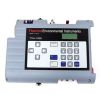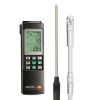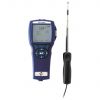Off Gas Treatment can be defined as improving the off gas quality before it’s discharged to the atmosphere, minimizing the impact to human health or the environment.
The two main methods for off gas treatment are using vapor phase carbon or an oxidizer.
When using vapor phase carbon for off gas treatment you want to consider air flow, air pressure, air temperature, contamination type and concentration. The air flow volume and desired back pressure will dictate the size and pipe size of the carbon vessel. The air pressure will determine the construction of the vessel as different types and construction materials stand up to different levels of pressure. Carbon efficiency is reduced at higher temperatures, so if the off gas temperature exceeds 140F it’s best to use an after cooler before carbon filtration to maximize the efficiency. The contamination type will determine if carbon is the best method for off gas treatment as some constituents are better absorbed by carbon than others. The contamination concentration will help determine vessel size and whether carbon or an oxidizer is the appropriate method for off gas treatment as the higher the concentration is the more quickly carbon will become spent.
An oxidizer is another option for off gas treatment. Oxidizers can be thermal, catalytic, or both. Oxidizers are fueled by either gas (typically propane or natural gas) or electricity. Thermal oxidizers operate at a higher temperature and are able to handle higher concentrations at a given flow rate. Thermal oxidizers also use more fuel or more electricity because they operate at a higher temperature. Catalytic oxidizers operate at a lower temperature but use a catalyst material to help treat the off gas. Catalytic oxidizers operate at a lower temperature but generally handle lower vapor concentrations than similarly sized thermal oxidizers.
When dealing with chlorinated solvents, an oxidizer rated to handle chlorinated solvents must be used. These oxidizers are typically constructed from stainless steel and often times include an acid scrubber because of the hydrochloric acid that is produced from treating chlorinated solvents with an oxidizer.
Control Panels are necessary to operate an Oxidizer. Controls range from a simple manual valve system with burner controls to advanced programmable logic controllers (PLC), motorized valves and remote telemetry. Enviro-Equipment Inc. has an UL 508A and 698A licensed control panel shop in house to design, build and troubleshoot your control systems.
Several instruments can be used with off gas treatment. A Testo 445 or TSI-9565-P can be used to measure air velocity, percent relative humidity and air temperature. Flame Ionization Detectors (FID) or Photoionization Detectors (PID) can be used to measure hydrocarbon vapor concentration.
For assistance on your off gas treatment application please contact one of our trained professionals.
Visit our Off Gas Treatment Remediation Systems page to view the new Off Gas Treatment remediation equipment that we offer.



